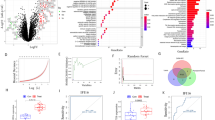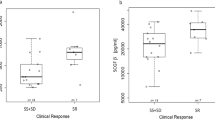Abstract
Background
Nephrotic syndrome (NS) is a common kidney disease in children. While Steroid-Sensitive Nephrotic Syndrome (SSNS) is frequently observed, Steroid-Resistant Nephrotic Syndrome (SRNS) has a poor prognosis and often leads to chronic kidney disease. The pathogenesis of SRNS is complex, with immunological modulation of T helper subtypes 1 and 2 cytokines increasing susceptibility to the disease. Currently, no established biomarkers can accurately predict SRNS. However, a group of cytokines might serve as potential indicators of responsiveness, aiding in the identification of patients with SRNS. The discovery of these cytokines as novel biomarkers for early diagnosis could greatly benefit patients. This includes preventing the adverse effects of glucocorticoid treatment and enabling a timely transition to more effective therapeutic alternatives.
Methods
This study aims to investigate the association between the gene expression patterns of cytokines, including IL-2, IL-4, IL-5, IL-6, IL-9, IL-10, IL-13, IL-17A, NF-κB, and TNFα, in healthy participants (n = 100), SSNS patients (n = 100), and SRNS patients (n = 100). Using qRT-PCR, followed by Receiver-operating characteristic analysis, the study assesses their potential as biomarkers. Additionally, clinicodemographic data were analyzed, and bioinformatic analyses such as coexpression analysis, gene enrichment, pathway analysis, and Cytoscape were performed to enhance our understanding of the inflammatory cascade initiating podocyte injury in NS.
Results
The results of our study suggest that specific candidate genes, including IL-2, IL-5, IL-6, IL-9, IL-17A, IL-10, IL-13, and TNFα, exhibit upregulation and hold significant importance, with an Area Under the Curve value of 0.9.
Conclusion
These genes have the potential to serve as valuable prognostic and management tools for NS, forming a promising panel of inflammatory gene biomarkers. Furthermore, conducting an extensive analysis that integrates cytokine genes with their respective targeted microRNAs could offer deeper insights into the pathogenesis of the disease.





Similar content being viewed by others
Data availability
No datasets were generated or analysed during the current study.
References
Noone DG, Iijima K, Parekh R (2018) Idiopathic nephrotic syndrome in children. Lancet 392:61–74
Banh THM, Hussain-Shamsy N, Patel V et al (2016) Ethnic differences in incidence and outcomes of childhood nephrotic syndrome. Clin J Am Soc Nephrol 11:1760–1768
Hodson EM, Willis NS, Craig JC (2007) Corticosteroid therapy for nephrotic syndrome in children. Cochrane Database Syst Rev 18(3):CD001533. https://doi.org/10.1002/14651858.CD001533.pub5
Kim JS, Bellew CA, Silverstein DM et al (2005) High incidence of initial and late steroid resistance in childhood nephrotic syndrome. Kidney Int 68:1275–1281
Tapia C, Bashir K. Nephrotic Syndrome. 2023. In: StatPearls [Internet]. Treasure Island (FL): StatPearls Publishing; 2023.
Kang HG (2011) Treatment of steroid-resistant pediatric nephrotic syndrome. Korean J Pediatr 54(8):317–321. https://doi.org/10.3345/kjp.2011.54.8.317
Horinouchi T, Nozu K, Iijima K (2022) An updated view of the pathogenesis of steroid-sensitive nephrotic syndrome. Pediatr Nephrol 37(9):1957–1965. https://doi.org/10.1007/s00467-021-05401-4
Kaneko K, Tsuji S, Kimata T, Kitao T, Yamanouchi S, Kato S (2015) Pathogenesis of childhood idiopathic nephrotic syndrome: a paradigm shift from T-cells to podocytes. World J Pediatrics 11(1):21–28. https://doi.org/10.1007/s12519-015-0003-9
Hackl A, Zed SEDA, Diefenhardt P, Binz-Lotter J, Ehren R, Weber LT (2021) The role of the immune system in idiopathic nephrotic syndrome. Mol Cell Pediatr 8(1):18. https://doi.org/10.1186/s40348-021-00128-6.PMID:34792685
Lawrence T (2009) The nuclear factor NF-kappaB pathway in inflammation. Cold Spring Harb Perspect Biol 1(6):a001651. https://doi.org/10.1101/cshperspect.a001651
Patrone D, Alessio N, Antonucci N, Brigida AL, Peluso G, Galderisi U, Siniscalco D (2022) Optimization of peripheral blood mononuclear cell extraction from small volume of blood samples: potential implications for children-related diseases. Methods Protoc 5(2):20. https://doi.org/10.3390/mps5020020.
Unal I (2017) Defining an optimal cut-POINT value in ROC analysis: an alternative approach. Comput Math Methods Med 2017:3762651. https://doi.org/10.1155/2017/3762651
Montenegro JD (2022) Gene Co-expression network analysis. Methods Mol Biol 2443:387–404. https://doi.org/10.1007/978-1-0716-2067-0_19
Clough E, Barrett T (2016) The gene expression omnibus database. Methods Mol Biol 1418:93–110. https://doi.org/10.1007/978-1-4939-3578-9_5.
Reimand J, Isserlin R, Voisin V, Kucera M, Tannus-Lopes C, Rostamianfar A, Wadi L, Meyer M, Wong J, Xu C, Merico D, Bader GD (2019) Pathway enrichment analysis and visualization of omics data using g:Profiler, GSEA. Cytoscape EnrichmentMap Nat Protoc 14(2):482–517. https://doi.org/10.1038/s41596-018-0103-9.
Zu F, Liu P, Wang H, Zhu T, Sun J, Sheng W, Tan X (2020) Integrated analysis identifies a pathway-related competing endogenous RNA network in the progression of pancreatic cancer. BMC Cancer 20(1):958. https://doi.org/10.1186/s12885-020-07470-4.
Parameswaran N, Patial S (2010) Tumor necrosis factor-α signaling in macrophages. Crit Rev Eukaryot Gene Expr 20(2):87–103. https://doi.org/10.1615/critreveukargeneexpr.v20.i2.10.
Huang YS, Fu SH, Lu KC, Chen JS, Hsieh HY, Sytwu HK, Wu CC (2017) Inhibition of tumor necrosis factor signaling attenuates renal immune cell infiltration in experimental membranous nephropathy. Oncotarget 8(67):111631–111641. https://doi.org/10.18632/oncotarget.22881.
Salsano ME, Graziano L, Luongo I, Pilla P, Giordano M, Lama G (2007) Atopy in childhood idiopathic nephrotic syndrome. Acta Paediatr 96(4):561–566. https://doi.org/10.1111/j.1651-2227.2007.00154.x
Shu KH, Lee SH, Cheng CH, Wu MJ, Lian JD (2000) Impact of interleukin-1 receptor antagonist and tumor necrosis factor-alpha gene polymorphism on IgA nephropathy. Kidney Int 58(2):783–789. https://doi.org/10.1046/j.1523-1755.2000.00227.x
van der Paardt M, Crusius JB, García-González MA, Baudoin P, Kostense PJ, Alizadeh BZ, Dijkmans BA, Peña AS, van der Horst-Bruinsma IE (2002) Interleukin-1beta and interleukin-1 receptor antagonist gene polymorphisms in ankylosing spondylitis. Rheumatology (Oxford) 41(12):1419–1423. https://doi.org/10.1093/rheumatology/41.12.1419
Mann CL, Davies MB, Stevenson VL, Leary SM, Boggild MD, Ko Ko C, Jones PW, Fryer AA, Strange RC, Thompson AJ, Hawkins CP (2002) Interleukin 1 genotypes in multiple sclerosis and relationship to disease severity. J Neuroimmunol 129(1–2):197–204. https://doi.org/10.1016/s0165-5728(02)00181-9
Shannon P, Markiel A, Ozier O, Baliga NS, Wang JT, Ramage D, Amin N, Schwikowski B, Ideker T (2003) Cytoscape: a software environment for integrated models of biomolecular interaction networks. Genome Res 13(11):2498–2504. https://doi.org/10.1101/gr.1239303.
Su G, Morris JH, Demchak B, Bader GD (2024) Biological network exploration with Cytoscape 3. Curr Protoc Bioinform 47(1):8–13. https://doi.org/10.1002/0471250953.bi0813s47
Ahmadian E, Rahbar Saadat Y, Dalir Abdolahinia E, Bastami M, Shoja MM, Zununi Vahed S, Ardalan M (2022) The role of cytokines in nephrotic syndrome. Mediators Inflamm 9(2022):6499668. https://doi.org/10.1155/2022/6499668.
Davin JC, Rutjes NW (2011) Nephrotic syndrome in children: from bench to treatment. Int J Nephrol 2011:372304. https://doi.org/10.4061/2011/372304
Jaiswal N, Prasad VA et al (2014) Regulatory and effector T cells changes in remission and resistant state of childhood nephrotic syndrome. Ind J of Nephrol 24(6):349–355
Sun XM, Sun XH, Li ZY, Yuan CJ, Wu J (2019) Expression of NF-κB in juvenile rats with nephrotic syndrome and its effects on inflammatory changes and renal injury. Eur Rev Med Pharmacol Sci 23(9):4010–4016
An Z, Qin J, Bo W, Li H, Jiang L, Li X, Jiang J (2022) Prognostic value of serum interleukin-6, NF-κB plus MCP-1 assay in patients with diabetic nephropathy. Dis Markers 17(2022):4428484. https://doi.org/10.1155/2022/4428484.PMID:35756496;PMCID:PMC9232375
Masutani K, Taniguchi M, Nakashima H, Yotsueda H, Kudoh Y, Tsuruya K (2004) Up-regulated interleukin-4 production by peripheral T-helper cells in idiopathic membranous nephropathy. Nephrol Dial Transpl 19:580–586
Jafar T, Agrawal S, Mahdi AA, Sharma RK, Awasthi S, Agarwal GG (2011) Cytokine gene polymorphism in idiopathic nephrotic syndrome children. Indian J Clin Biochem 26(3):296–302. https://doi.org/10.1007/s12291-011-0126-2
Youssef DM, Elbehidy RM, El-Shal AS, Sherief LM (2015) T helper 1 and T helper 2 cytokines in atopic children with steroid-sensitive nephrotic syndrome. Iran J Kidney Dis 9(4):298–305
Abdulqawi K, El-Mahlaway A, Badr G, Abdulwahab A (2013) serum cytokines and histopathological pattern of idiopathic nephrotic syndrome in saudi children. J Interdiscip Histopathol. https://doi.org/10.5455/jihp.20121218070911
Al-Eisa AA, Al Rushood M, Al-Attiyah RJ (2017) Urinaryexcretion of IL-1β, IL-6 and IL-8 cytokines during relapse and remission of idiopathic nephrotic syndrome. J Inflamm Res 10:1–5
Aviles DH, Vehaskari VM, Manning J, Ochoa AC, Zea AH (2004) Decreased expression of T-cell NF-kappaB p65subunit in steroid-resistant nephrotic syndrome. Kidney Int 66(1):60–67
Lama G, Luongo I, Tirino G, Borriello A, Carangio C, Salsano ME (2002) T-lymphocyte populations and cytokines in childhood nephrotic syndrome. Am J Kidney Dis 39(5):958–965. https://doi.org/10.1053/ajkd.2002.32769
Cortvrindt C, Speeckaert R, Moerman A, Delanghe JR, Speeckaert MM (2017) The role of interleukin-17A in the pathogenesis of kidney diseases. Pathology 49(3):247–258. https://doi.org/10.1016/j.pathol.2017.01.003
Tanabe K, Matsushima-Nishiwaki R, Yamaguchi S, Iida H, Dohi S, Kozawa O (2010) Mechanisms of tumor necrosis factor-alpha-induced interleukin-6 synthesis in glioma cells. J Neuroinflammation 6(7):16. https://doi.org/10.1186/1742-2094-7-16.
Milas O, Gadalean F, Vlad A, Dumitrascu V, Velciov S, Gluhovschi C, Bob F, Popescu R, Ursoniu S, Jianu DC, Matusz P, Pusztai AM, Secara A, Simulescu A, Stefan M, Patruica M, Petrica F, Vlad D, Petrica L (2020) Pro-inflammatory cytokines are associated with podocyte damage and proximal tubular dysfunction in the early stage of diabetic kidney disease in type 2 diabetes mellitus patients. J Diabetes Complicat 34(2):107479
Acknowledgements
We are grateful to every patient who took part in this research.
Funding
No funding.
Author information
Authors and Affiliations
Contributions
Yogalakshmi.V conceptualized and planned the research. Praveen Kumar.K.S. played a key role in data collection and formal analysis. The initial draft of the manuscript was prepared by B. Thendral Hepsibha Balraj, Vettriselvi.V, and Sangeetha.G. Mohana Priya contributed to manuscript reviews, offering valuable insights and conducting revisions, thereby ensuring improved accuracy and content quality. Mohana Priya also provided supervision throughout the study. All authors have reviewed and given their approval for the final manuscript.
Corresponding author
Ethics declarations
Conflict of interest
The authors declare no conflict of interest.
Ethical approval
This study obtained approval from the Institutional Ethics Committee of Sri Ramachandra Institute of Higher Education and Research (SRIHER), Porur, Chennai, with the reference number: IEC-NI/22/JUL/83/71.
Research involving human and/or animal participants
Patients or the public were not involved in the design, conduct, reporting, or dissemination plans of our research.
Consent to participate
Samples collected after obtaining informed consent from parents or guardians.
Consent of publication
Not applicable.
Additional information
Publisher's Note
Springer Nature remains neutral with regard to jurisdictional claims in published maps and institutional affiliations.
Rights and permissions
Springer Nature or its licensor (e.g. a society or other partner) holds exclusive rights to this article under a publishing agreement with the author(s) or other rightsholder(s); author self-archiving of the accepted manuscript version of this article is solely governed by the terms of such publishing agreement and applicable law.
About this article
Cite this article
Venkatachalapathy, Y., Suresh, P.K.K., Balraj, T.H. et al. Clinico-demographic and biochemical correlation of inflammatory gene expression in pediatric nephrotic syndrome. Mol Biol Rep 51, 854 (2024). https://doi.org/10.1007/s11033-024-09784-z
Received:
Accepted:
Published:
DOI: https://doi.org/10.1007/s11033-024-09784-z




